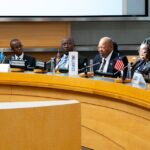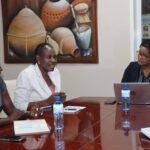Today’s holiday (1st July) marks the ninety-ninth anniversary of the birth of our country’s founding President, the late Sir Seretse Khama (1921-80).When our country’s first President, the late Sir Seretse Khama, assumed office –newly independent Botswana was an impoverished and internationally obscure state.
He left it an increasingly prosperous and internationally respected nation based on the principles of democracy and development.Seretse Khama was born in 1921 at Serowe as the son and heir Sekgoma Khama and Tebogo (nee Kebailele). In 1923 his father succeeded his grandfather as the Kgosi or ruler of the Bangwato.
His reign, as Kgosi Sekgoma II was, however, short as he died in 1925. With the death of his mother, in 1930, Seretse remained in the care of his uncle Tshekedi Khama, who ruled the Bangwato as his regentSeretse received his higher primary and secondary education in South Africa, at two prominent mission schools, Lovedale and Tiger Kloof, before earning a Bachelor of Arts degree at Fort Hare College.
Thereafter he studied law at the University of Witwatersrand and Balloil College, Oxford, before taking up further Barrister Studies at Inner Temple in London.In June 1947, while in London, Seretse first met Ruth Williams, who was then pursuing a career in the financial sector. Their interracial marriage in September 1948 ultimately threw the British Empire into turmoil. Initially his uncle, Tshekedi, ordered Seretse home to demand a divorce. But, after a series of public meetings in Serowe, Seretse was popularly recognised as Kgosi together with his wife. Tshekedi then gave way and went into self-exile.But, the proclamation of a black chief with a white wife, in a territory strategically located between South Africa and the Rhodesias, caused outcry among white settler politicians.
South Africa had come under the control of white Afrikaner nationalists in 1948.Eager to secure its economic and political ties with the Apartheid regime the then British government decided to bar Seretse Khama from chieftainship. But, the persecution of Seretse and Ruth Khama received extensive international press coverage and outrage was expressed by a wide range of people around the world. In 1956, the British finally allowed the couple to return to Botswana as private citizens.From 1957-62 Seretse Khama was involved in the reform of local and territorial Government leading to the establishment of a Legislative Council as key steps towards decolonisation.
In 1962 he founded the Bechuanaland Democratic Party (BDP). The party won the first universal franchise elections in March 1965, allowing Seretse Khama became the first prime minister of a self-governing Bechuanaland Protectorate before leading the country to full independence a year later.At independence Botswana was entirely surrounded by white racist regimes.
It was, therefore, widely but falsely assumed that the country had no option but to sell-out to its neighbours, South Africa (including occupied South-West Africa) and Southern Rhodesia.The new government, moreover, could not cover the costs of administration from taxes, and was continually indebted to Britain. The first task was to lay the groundwork for an export-oriented economy, based on beef processing and copper and diamond mining.
Under Seretse Khama Botswana became the world’s fastest growing economy. It also came to be seen as state with high principles, upholding liberal democracy and non-racialism in the midst of a region embroiled in civil war, racial enmity and corruption. State mineral revenues were invested in infrastructural development, education and health, and in subsidies to cattle production, resulting in increased general prosperity, in rural as well as urban areas.
As Botswana progressed, Seretse Khama was also able to turn more of his attention to foreign policy, finding key early allies in Presidents Kaunda of Zambia Nyerere of Tanzania. In his final decade he played and increasingly prominent role as a Pan African statesman. He was one of the “Front-Line Presidents” who negotiated the future of Zimbabwe and Namibia. In the face of the terrorist activities of the Smith regime in particular, the Botswana Defence Force was created to guard Botswana’s borders, protecting growing numbers of refugees as well as the citizenry.
During this period Seretse Khama articulated a clear vision of the future of Southern Africa after colonialism and apartheid, as a peaceful, democratic and prosperous region. He was thus the key founder of what has since become the Southern African Development Community.
In his final year the rigours of constant travel for international negotiations, leading up to the independence of Zimbabwe, exhausted Seretse Khama. But he had the final satisfaction of witnessing both the independence of Zimbabwe in March 1980 and the launching of the Southern African Development Coordination Conference in April, before his death on the 13th July 1980.
Botswana’s first President is fondly remembered for his intelligence, integrity, and sense of humour. Of his lasting legacy it can said that the perpetual democracy, socio-economic development, political stability and unity that Batswana experience today are what Sir Seretse Khama stood for.










